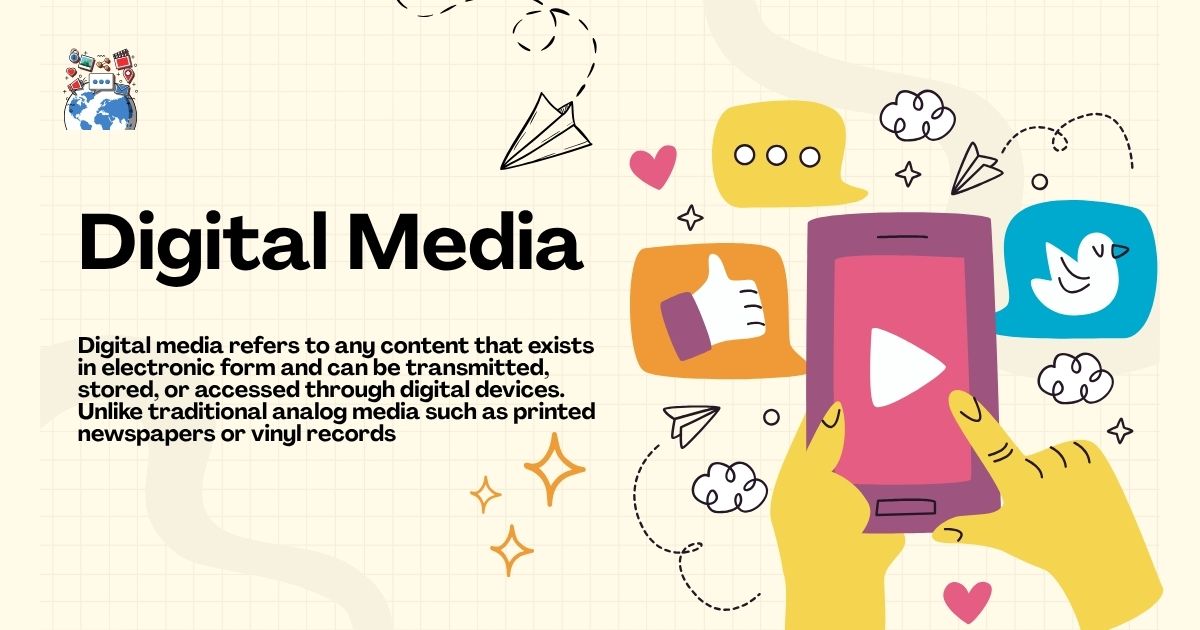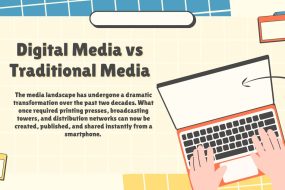
Digital media has transformed how we consume, create, and share information. From streaming your favorite TV show to scrolling through social media feeds, digital platforms have become the primary way people access entertainment, news, and educational content. Understanding digital media is crucial for businesses, content creators, and anyone looking to stay relevant in our connected world.
This comprehensive guide explores what media encompasses, the various types available, real-world examples, and why it has become indispensable for modern communication and business success. Whether you’re a marketing professional, educator, or simply curious about the digital landscape, you’ll gain valuable insights into this dynamic field.
The shift from traditional print and broadcast media to digital platforms represents one of the most significant communication revolutions in human history. By the end of this post, you’ll understand how digital media works, its key advantages, and how to leverage it effectively for your personal or professional goals.
Understanding Digital Media: The Foundation
Digital media refers to any content that exists in electronic form and can be transmitted, stored, or accessed through digital devices. Unlike traditional analog media such as printed newspapers or vinyl records, digital media converts information into binary code—the language of computers consisting of ones and zeros.
This conversion process allows for incredible versatility. Text, images, audio, and video can all be compressed, edited, and distributed instantly across global networks. The interactive nature of sets it apart from traditional formats, enabling two-way communication between creators and audiences.
Digital media encompasses everything from websites and mobile apps to podcasts and virtual reality experiences. The common thread connecting all digital media formats is their reliance on electronic devices for creation, distribution, and consumption. This dependency has created new opportunities for engagement while also presenting unique challenges for content creators and consumers alike.
Types of Digital Media: A Comprehensive Breakdown
Text-Based Digital Media
Written content forms the backbone of digital communication. Websites, blogs, e-books, and online articles represent the evolution of traditional print media into digital formats. Search engines primarily index text content, making written digital media crucial for online visibility and information discovery.
Email newsletters, social media posts, and instant messaging platforms demonstrate how text-based digital facilitates real-time communication. The interactive nature of digital text allows for features impossible in print, such as hyperlinks, searchable content, and automatic translation.
Visual Digital Media

Images and graphics serve as powerful communication tools in the digital space. Digital photography has revolutionized visual storytelling, while infographics transform complex data into easily digestible visual formats. Social media platforms like Instagram and Pinterest have built entire ecosystems around visual content sharing.
Digital art and design tools have democratized creative expression, allowing anyone with a computer to create professional-quality graphics. Stock photo websites, digital galleries, and online portfolios showcase the vast potential of visual digital media for both artistic and commercial purposes.
Audio Digital Media
Sound has found new life in digital formats through podcasts, streaming music services, and audiobooks. Digital audio offers superior quality control, infinite reproduction without degradation, and global distribution capabilities that traditional radio and physical recordings cannot match.
Voice assistants and smart speakers represent emerging frontiers in audio digital media, creating new opportunities for interactive sound experiences. Digital audio editing tools have made professional-quality sound production accessible to independent creators and small businesses.
Video Digital Media
Moving images combine visual and audio elements to create compelling digital experiences. Video streaming platforms have disrupted traditional television and film industries, while short-form video content on social media platforms has created entirely new entertainment categories.
Live streaming capabilities enable real-time video communication for everything from business meetings to entertainment broadcasts. Interactive video features, such as clickable elements and choose-your-own-adventure formats, showcase the unique possibilities of digital video content.
Interactive Digital Media
Games, apps, and interactive websites represent the most engaging forms of digital media. These formats require active participation from users, creating immersive experiences that traditional media cannot replicate. Educational software and training programs leverage interactivity to improve learning outcomes.
Virtual and augmented reality technologies push the boundaries of interactive digital media, creating entirely new categories of digital experiences. These emerging formats promise to revolutionize fields ranging from entertainment and education to healthcare and professional training.
Real-World Examples of Digital Media in Action
Social Media Platforms
Facebook, Instagram, Twitter, LinkedIn, and TikTok demonstrate how digital media creates global communities around shared interests. These platforms combine multiple media types—text, images, video, and interactive elements—to facilitate social connections and influencer marketing.
Each platform has developed unique content formats optimized for specific user behaviors and preferences. Instagram Stories showcase ephemeral visual content, while LinkedIn articles provide professional networking through long-form text content.
Streaming Services
Netflix, Spotify, YouTube, and similar platforms have revolutionized content consumption by providing on-demand access to vast media libraries. These services use sophisticated algorithms to personalize content recommendations, demonstrating how digital media can adapt to individual preferences.
The subscription model popularized by streaming services has created sustainable revenue streams for content creators while providing consumers with affordable access to premium content.
E-commerce and Digital Marketing
Online stores combine product images, videos, reviews, and interactive features to create compelling shopping experiences. Digital marketing campaigns leverage targeted advertising, email marketing, and content marketing to reach specific audiences with precision impossible in traditional media.
Customer relationship management systems use digital media to maintain ongoing communication with customers through personalized email campaigns, social media engagement, and targeted advertising.
Educational Technology
Online learning platforms, educational apps, and digital textbooks demonstrate how media enhances educational experiences. Interactive simulations, video lectures, and gamified learning experiences cater to different learning styles while providing flexible access to educational content.
Virtual classrooms enable global access to education, breaking down geographical barriers that traditionally limited learning opportunities.
The Critical Importance of Digital Media
Global Reach and Accessibility
Digital media eliminates geographical boundaries, allowing content creators to reach global audiences instantly. This unprecedented reach creates opportunities for businesses, educators, and artists to connect with people worldwide without the traditional barriers of physical distribution networks.
Accessibility features built into digital platforms help ensure content reaches people with disabilities. Screen readers, closed captions, and adjustable text sizes make digital media more inclusive than many traditional formats.
Cost-Effective Content Distribution
Publishing digital content costs significantly less than traditional media relation production and distribution. Small businesses and individual creators can compete with large organizations by producing high-quality digital content without massive upfront investments.
The elimination of printing, shipping, and physical storage costs makes digital economically attractive for both creators and consumers. Updates and corrections can be implemented instantly without reprinting or redistributing physical materials.
Real-Time Analytics and Optimization

Digital platforms provide detailed analytics about audience behavior, engagement rates, and content performance. This data enables creators to optimize their content strategies based on concrete evidence rather than guesswork.
A/B testing capabilities allow for systematic improvement of digital media campaigns, leading to better results and higher return on investment over time.
Enhanced Engagement and Interactivity
Digital media enables two-way communication between creators and audiences through comments, shares, likes, and direct messaging. This interactivity creates stronger relationships and more engaged communities around content.
Personalization features allow digital media to adapt to individual user preferences, creating more relevant and engaging experiences than traditional one-size-fits-all media formats.
Environmental Sustainability
Digital media reduces paper consumption, physical transportation, and manufacturing waste associated with traditional media production. Cloud storage and digital distribution create more environmentally sustainable media consumption patterns.
The ability to update and repurpose digital content extends its lifespan and reduces the need for completely new production cycles.
Future Trends Shaping Digital Media
Artificial intelligence and machine learning technologies are beginning to automate content creation and curation processes. These tools help creators produce more personalized content while enabling platforms to deliver more relevant experiences to users.
Voice-activated interfaces and smart home devices are creating new opportunities for audio-first digital media experiences. Conversational interfaces may fundamentally change how people interact with digital content.
Blockchain technology promises to revolutionize digital media ownership and monetization by enabling new models for content creators to be compensated directly by their audiences.
Maximizing Your Digital Media Strategy
Success in media requires understanding your target audience and choosing the right platforms and formats for your message. Different demographics press release different types of digital media, making audience research crucial for effective communication.
Consistency across multiple channels helps build recognizable brand identity and increases the likelihood of audience engagement. Regular content publication schedules help maintain audience attention and improve search engine visibility.
Quality remains paramount despite the ease of digital publishing. High-quality content that provides genuine value to audiences will always outperform low-effort content, regardless of the digital platform or format used.



















No Comments